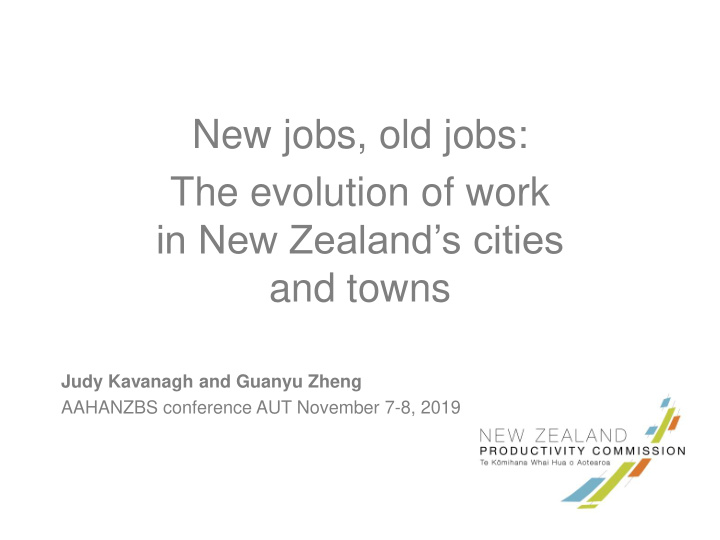



New jobs, old jobs: The evolution of work in New Zealand’s cities and towns Judy Kavanagh and Guanyu Zheng AAHANZBS conference AUT November 7-8, 2019
We’ve seen a lot of change since 1976… 2
… in 2019 3
This talk is about other big changes… …in the places people live and the work they do Access to the anonymised data used in this study was provided by Statistics New Zealand in accordance with security and confidentiality provisions of the Statistics Act 1975 [and secrecy provisions of the Tax Administration Act 1994]. The findings are not Official Statistics. The results in this paper are the work of the authors, not Statistics NZ nor New Zealand Productivity Commission, and have been confidentialised to protect individuals from identification.
Data • Historic Census data from 1976 to 2013 • 30 primary and secondary cities • Primary cities have at least 30,000 usual residents in 2013 • Secondary cities have 10,000 – 29,999 usual residents in 2013 • Employment (employees and employers) in 65 industries. • Manufacturing industries are broadly grouped into two categories • Widely-distributed manufacturing • Regionally-specialised manufacturing
Manufacturing • Widely-distributed manufacturing – Fabricated metal, printing, other, petrochem, electronic, transport and equipment, non-metallic, machinery, clothing, fruit process • Regionally-specialised manufacturing – Textile, food and beverage, primary metal, wood process, meat and fish, dairy process, pulp and paper 6
The big shift away from manufacturing… 7
… and a rise in the financial sector especially in Auckland 8
Services employment has seen a disproportionate increase in Auckland Predictions were calculated based on national industry and city employment growth 9
Auckland grew but it didn’t have the fastest growth rate 10
Queenstown then… 11
Queenstown now… 12
Some places grew because they are nice places to live… like Tauranga 13
Tauranga now… 14
Kapiti 15
A few places have experienced decreased employment like Wanganui… 16
Oamaru 17
Tokoroa then… 18
Tokoroa now… 19
Shift-share analysis • Local employment growth is decomposed into four factors – National growth factor (NG) captures the extent that employment growth in an urban area is due to national industry trends. – Industry mix factor (IM) captures the effect of local industry structure on city employment growth – Dynamic employment factor (DM) captures the extent local industry employment growth exceeds average industry growth – Convergence factor (AL) captures the extent that a local industry mix is diverging or converging to the national average.
Shift-share decomposition, 1976 - 2013
Fast growing cities experienced fast expansion in non-tradable services 22
Shift-share analysis, 1976 - 2013
Regional specialisation index 24
How the regional specialisation index was calculated
Places have become more diversified over time… and more like each other
Some changes haven’t been so surprising…. The decline in manufacturing has mirrored the experience of other countries. Many of the new jobs created over the last four decades have been in service industries where agglomeration effects matter. This has tended to favour large cities, of which ours is Auckland. 27
But there’s been some insights for New Zealand…. People have become attracted to places to live that have good amenities and a good climate. Employment in these places has grown to service the population growth. Towns that were highly specialised in manufacturing or primary product processing, and that couldn’t offer good amenity, have struggled. 28
And we’ve raised some interesting questions for further study 29
Thank you Visit our website to find out more and to subscribe to updates: www.productivity.govt.nz
Recommend
More recommend